VVAM Newsletter 50 – 1993
Utrechtseweg 232 6862 AZ Oosterbeek
Tel. editorial staff 085-337515
NEWSLETTER No. 50, May 1993
Editorial staff:
Drs. R.P.G.A. Voskuil
C. van Roekel
G.H. Maassen jr.
On the ocassion of the 50th Newsletter
The appearance of the 50th number of the Newsletter gives us the opportunity of pausing for a moment and reflecting on the amount of work that has been, and is, carried out to ensure that the letter appears four times per year in this size and in such a well presented manner. Except for the printing, all work is done voluntarily! The first Newsletter consisted of a modest two pages and appeared in November 1980, nine months after the setting up of the Society. Its aim was to keep the members “up to date with the ups and downs of our Society and, of course, with those of the Airborne Museum”. Our letter, which from its inception has appeared in both the Dutch and English language, has been edited by Mr. Voskuil since May 1981. In May 1983, Mr. Voskuil was joined by Mr. Van Roekel as co-editor. The introduction of the Ministory offered the opportunity of drawing attention to the happenings in 1944 as well as providing present day information.
The editors put in many of their spare time hours before the letter is ready for printing. We are deeply indebted to them for the care and time they give and for the enthusiasm with which they still carry out the work. We thank Mr. De Reus and Mr. De Ruyter for their photographic work and a big thank you also goes to Mrs. Meeuwsen who, for years, has looked after the English translations.
Envelope filling and the sticking on of 1100 address labels is not the most inspiring of jobs but it is indeed an essential one. Our heartfelt thanks goes to those members who carry this out.
Through his relocation, the lines of communication between the printer and the editors have become too long. For this reason we have gone over to another printer, in spite of the good quality of the previously supplied product.
The editorial staff, now expanded with the introduc-tion of Mr. Maassen, will continue to provide you with news in their well known, inimitable style, under the auspices of the directorate.
Drs. J. Smits, chairman
From the editors
Following on from the Airborne Museum’s example, it is also high time that the Newsletter and the Mini-story received a “facelift”. Therefore, this 50th edition appears in a completely new form. From now on, not only will the text be processed in the computer and printed in two columns, but the “head” of both publications has been given a totally new look. This was designed by Mr. Jan Vogel of the “3A design” advertising agency in Oosterbeek. We would like to point out that this design was done completely free of charge for which, you will understand, we are most grateful.
Obituary: Frank Young
We have received the sad news that Mr. Frank Young passed away unexpectedly on Easter Sunday. From 1986 up to 1990, Frank Young was our society’s representative in Great Britain. During that period he
did a tremendous amount of work with great enthu-siasm.
During the Battle of Arnhem he served at the head-quarters of the Royal Corps of Signals. Mr. McFarlane served in the same unit. It was he, Mr. McFarlane, who took the photograph of the six-pounder at the corner of the Utrechtseweg and Klingelbeekseweg in Arnhem which was printed in issue No. 43 of the Newsletter. Through this photo Frank Young re-established contact with his former colleague. They had made an appointment, by telephone, to meet one another again for the first time in 50 years. Sadly that is now no longer possible. We shall miss Frank Young’s cheerful personality.
Excursion on Saturday 3 July next
This year, the society’s excursion will have “Operation BERLIN” as its topic. This was the code name given to the withdrawal across the Rhine of the remnants of the 1st British Airborne Division on the night of 25/26 September 1944.
The routes followed by the soldiers to the Rhine that night ran mostly along woodland paths and through water meadows. In order to obtain as good an impression as possible of the terrain over which the withdrawal took place, it has been decided that one of the 1944 routes will be followed entirely on foot during the excursion on 3 July.
The provisional programme is as follows:
9.30-10.00: Reception with coffee in the Airborne Museum.
10.00-10.30: Departure of the small groups with short breaks in between for the walk to the Rhine through the Hemelse Berg woods and the water meadows. At specific points along the route, guides will provide explanations.
From 1300: LLTNCH in the Concert Hall in the Lower village.
Approx. 14.30: Visit to the Old Church.
15.00: Departure from the Old Church for a walk to Hartenstein via the Beneden-Weverstraat and the Hazenakker. On the way guides will provide expla-nations.
Approx. 16.30: End of the excursion.
The total length of the route to be walked is about 4 kilometres and, because some of it will be on unpaved paths, strong walking shoes are recommended. The trip will go ahead even if it rains, so good rainwear is also advised.
Chris van Roekel is organising the excursion and those wishing to take part can do so by making out a cheque for 25 guilders on post giro number 4403641, payable to the Friends of the Airborne Museum Society, under the heading “excursion”. This sum covers coffee at the reception, lunch in the Concert Hall and the excursion guide.
The maximum number of participants is limited to around 100 and these places will be filled on a “first come first served” basis. Closing date for enrolment is 15 June.
From the 13th members meeting
After the first six points on the agenda had been dealt with without comment or observation, the subject of the Airborne Museum renovation plans came up for discussion. Mr. J.W. van Slooten, directorate member of the Airborne Museum Foundation, gave a clear explanation of the plans and answered questions put by those present. The concerned-critical question was posed; does the “renovation” indicate a change of course in museum policy? Will the chance to pause, in thoughts and feelings, and to reflect on the events of the Second World War be lessened or disappear completely, and will the exposition simply become a medium for expressing a specific vision on present day events? The answer was that the format and objective of the Airborne Museum would remain unchanged. The renovation concerned improvements in presentation, a new diorama and a new exposition room.
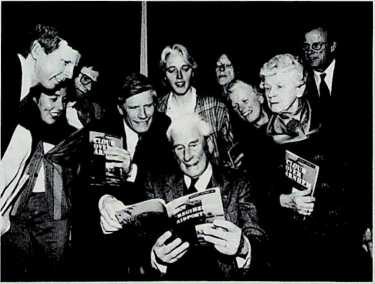
Encircled by his family, Mr. J. ter Horst inspects the first copy of the republished book, “Een Regimental Aidpost/ Cloud over Arnhem(Photo: B. de Rens)
The directorate announced that 30.000 guilders would be made available from Society funds for the new diorama. In addition to this, it was hoped that a minimum of 8.000 guilders would be raised for the same project through the “sale” of the rear wall of the diorama.
The directorate was delighted with the anonymous donation of 8.000 guilders which will be used for the renovation.
Mr. Van Roekel gave information regarding the organisation of a lottery, this on the initiative of six of our members. In this way, they want to make the renovation plans known to a wider public. By running a lottery they also hope to raise a substantial sum of money. The more members who cooperate in this the greater the chance of success. (J. Smits).
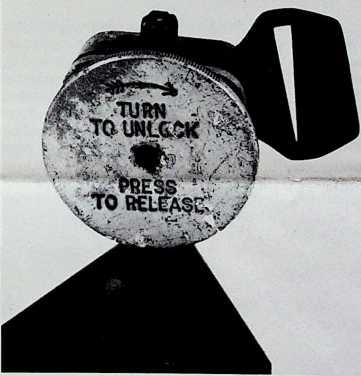
One of the presents that members can earn by selling ten or more lottery tickets is an original “clock” (quick release mechanism) from a parachute harness dating from 1944. (Photo: W. de Ruyter)
Official presentation of Kate ter Horst’s book
As already announced in the previous Newsletter, our Society has republished the book written by Mrs. Kate ter Horst about her dramatic experiences in September 1944. The book is published in both Dutch and English.
These editions were officially presented during a meeting at the Airborne Museum on 2 April. Our Society’s chairman, drs. J. Smits, opened the presentation with a look back at the events which took place in the Lower village in Oosterbeek in September 1944. “In that area people fought, grieved, prayed and died, but there also occurred deeds of common humanity and neighbourly love. Mrs. Ter Horst has become the personification of this”. Mr. Smits then related how the new edition, which was worked on by a team of people, came into being.
After this, Mr. Smits presented the first copies of “Een Regimental Aidpost”, and the English version “Cloud over Arnhem”, to Mr. J. ter Horst. In his word of thanks, spoken also on behalf of the members of his family who were present, Mr. Ter Horst resurrected memories of 1944 and 1945. His wife recorded the events and experiences of the time during her period of evacuation in Friesland by means of letters to her mother and others. This resulted in her story which has now been republished. Very moving, “in contrast to my more businesslike style”, Mr. Ter Horst remarked.
Besides Mr. Ter Horst’s account, the book also includes General Sir Frank King’s story. This British general, a captain in 1944, was among the wounded cared for in Kate ter Horst’s house.
These new editions differ from the original in that they contain many previously unpublished photographs. Both editions cost 15 guilders and are available at the Airborne Museum and in bookshops in the Netherlands. In Great Britain “Cloud over Arnhem” can be purchased through The Airborne Forces Appeal (£ 6.50 plus £ 1.00 for postage and packing when sold through mail order). Enquiries can be made at Rgt. H.Q. The Parachute Regiment, Browning Barracks, Aidershot, Hampshire GUI! 2BU.
Information days a huge success
For the first time the Airborne Museum held an information day on Saturday 3 April. The theme was material from the Second World War. This experiment appears to have been a huge success since many people took the opportunity of bringing along various objects and documents for the perusal of the experts present. One of the most remarkable was an Italian army Red Cross chest, but smaller objects and documents were also brought along. A most extraordinary item was a pamphlet which was dropped by the Germans over Oosterbeek in September 1944, inviting the British Airborne troops to surrender.
More than a thousand people visited the Airborne Museum on 17 and 18 April, the National Museum weekend. A number of our members had set up their personal collections for the public to inspect and ask questions about. Among these were Mr. R. Sigmond with his 7th Battalion, The King’s Own Scottish Bor-derers collection, Mr. R. Gerritsen with material con-cerning the liberation of Arnhem and Oosterbeek in April 1945, the “Arnhem Battle Research Group” comprising Mr. P. Vrolijk (study object, 1st Parachute Battalion), Mr. B. Kornet (11th Parachute Battalion) and Mr. P. Reinders (156th Parachute Battalion), and the Dutch Aircraft Examination Group under the direction of Mr. R. Markus. This last group is involved in the excavation of aircraft which crashed during the war.
High British decoration for Truus Oosterhaar
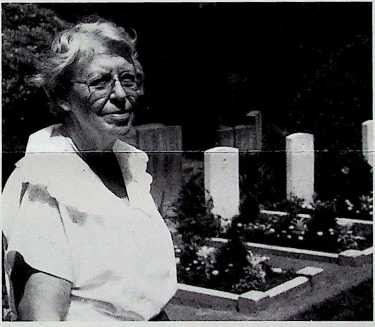
Truus Oosterhaar beside the graves of the Allied airmen which she has tended for fifty years. (Photo: B. de Reus)
Mrs. Truus Oosterhaar, one of our members from Arnhem, has been made “Honorary Member of the Most Excellent British Empire” (MBE) by Queen Elizabeth II of England. Mrs. Oosterhaar receives this honour in recognition of the fact that, for the last 50 years, she has tended the graves of allied airmen in Oosterbeek. In July 1942 and in February and June 1943, three bomber aircraft came down in the Renkum area, costing the lives of nine crew members. They were buried in the General Cemetery in Oosterbeek. Despite the risks involved due to the German occupation, the then thirteen year old Truus Oosterhaar cared for their graves; this she still does to this day. Every week she catches the bus from Arnhem to Oosterbeek, where she tends the graves with great devotion and dedication.
The decoration will be presented by the British Ambassador during the commemoration of the Battle of Arnhem in September.
The Airborne Museum renovation has begun
In March a start was made on the renovation of the Airborne Museum. The exposition rooms on the ground floor have been repainted, the photos and drawings renewed whereby the grouping was also amended. Next, is the improvement of the lighting. This first phase will be completed before the summer so that the other work can begin after the September remembrance.
The acquisition of funds for the renovation work is going extremely well. Up to now a sum of around 150.000 guilders has been raised.
Lottery
The lottery, organised by a number of our members, has been publicised by means of a letter to the Friends in the Netherlands. The success of the lottery lies in our hands, the Friends of the Airborne Museum; success is dependent on the members. You will also do something to help?! Friends do not just leave their friends and the Airborne Museum in the lurch, do they?
The “Polen van Driel” (the Poles of Driel) help the Airborne Museum
A new action has been initiated in connection with the raising of funds for the Airborne Museum renovation. It concerns the sale of the book “De Polen van Driel – De le Poolse Onafhankelijke Parachutistenbrigade van generaal-majoor Stanislaw Sosabowski tijdens de Slag om Arnhem in 1944” (“The Poles of Driel – The 1st Polish Independent Parachute Brigade of Major-General Stanislaw Sosabowski during the Battle of Arnhem in 1944”). This A4 format book, which comprises 152 pages with 290 illustrations, has been reduced in price from 29,95 guilders to 25 guilders. With each copy sold, the distributor and seller will donate a total of 5 guilders between them for the reorganisation and rebuilding of the museum. The author, George F. Cholewczynski, strongly supports this initiative.
The Oosterbeek book dealers Romijn and Meijer & Siegers are joining in this action as is, of course, our Society through sales in the Airborne Museum. Those interested can obtain the book direct from these sources.
Obituary: major Digby Tatham- Warter
Last March, the 75 year old Major Digby Tatham- Warter passed away in Kenya. During the Battle of Arnhem, he commanded “A” company of the 2nd Parachute Battalion. Major Tatham-Warter became one of the most talked about officers in the battle due to his extraordinary appearance. During the fighting around the bridge in Arnhem he wore a bowler hat and carried an umbrella for recognition since he could never remember the daily password. It also served as a morale booster for his troops.
When the battle for the Rhine bridge ended on 21 September 1944, the lightly wounded Tatham-Warter was made prisoner of war. Shortly afterwards he managed to escape and was taken into hiding by the Wildeboer family. With the aid of the Ede underground, of which Bill Wildeboer was the leader, he assisted with the organisation of the mass escape of British troops, “PEGASUS 1”, which took place on the night of 22/23 October 1944. In this operation approximately 120 men escaped through German lines to the other side of the Rhine.
In 1946 he emigrated to Kenya.
A character based on Major Tatham-Warter appeared in the 1977 film “A Bridge Too Far”.
For his conduct during and after the Battle of Arnhem
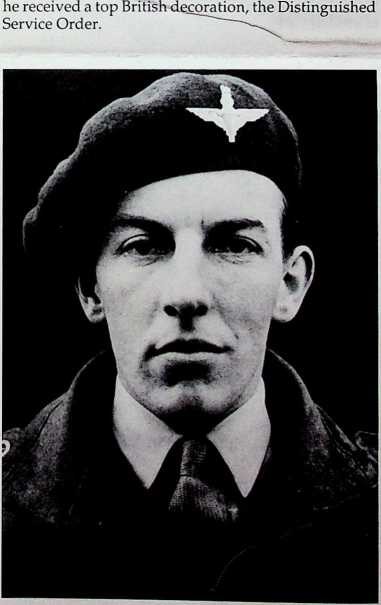
Major Digby Tatham-Warter in 1944. (Photo: Imperial War Museum)

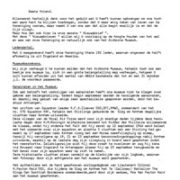
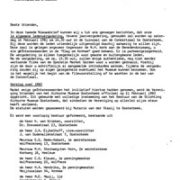
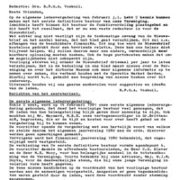
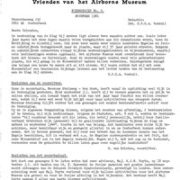
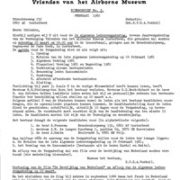
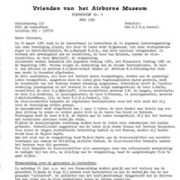
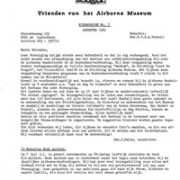
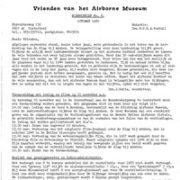
Plaats een Reactie
Vraag of reactie?Laat hier uw reactie achter.